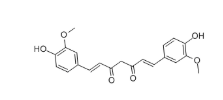Curcumin Details
Chemical Name: Curcumin
Synonyms: 1,7-Bis(4-hydroxy-3-methoxyphenyl)-1,6-heptadiene-3,5-dione; C.I. 75300; C.I. Natural Yellow 3; Diferuloylmethane
CAS No.: 458-37-7
Molecular Formula: C21H20O6
Molecular Weight: 368.38
Molecular Structure: 
Appearance: yellow powder
Typical Properties
| Melting point |
183 °C |
| density |
0.93 |
| Boiling point |
418.73°C (rough estimate) |
| FEMA |
2655 | L-MALIC ACID |
| solubility |
ethanol: 10 mg/mL |
Usage
Widely used in food, dishes, cakes, candy, canned drinks and cosmetics, medicine coloring.
-
Food Industry:
- Coloring agent: Used to impart a yellow color to foods like curry powders, mustards, and certain cheeses.
- Flavoring agent: Used in turmeric-flavored beverages, particularly in South and Southeast Asia.
- E number: In the European Union, its E number is E 100.
-
Dietary Supplements:
- Anti-inflammatory and antioxidant properties: Curcumin is widely used in dietary supplements for its potential to reduce inflammation and protect against cell damage from free radicals.
- Dosage: Clinical studies often use doses ranging from 500mg to 2000mg daily, but doses up to 8000mg are generally considered safe.
-
Research:
- Studying its effects on various diseases: Curcumin has been used in numerous research studies to investigate its potential therapeutic effects on a wide range of conditions, including cancer, Alzheimer’s disease, arthritis, and other inflammatory conditions.
- Investigating bioavailability and delivery methods: Researchers are actively exploring ways to improve curcumin’s bioavailability, as it is known to have poor absorption, rapid metabolism, and rapid elimination from the body.
-
Cosmetics:
- Anti-aging and skin care: Curcumin’s antioxidant and anti-inflammatory properties are also being explored for their potential benefits in skincare products.
Packaging and Shipping
25kg/drum
Storage
Store in a cool, dry, well – ventilated warehouse. Stay away from fire and heat. Prevent direct sunlight. Packing seal.